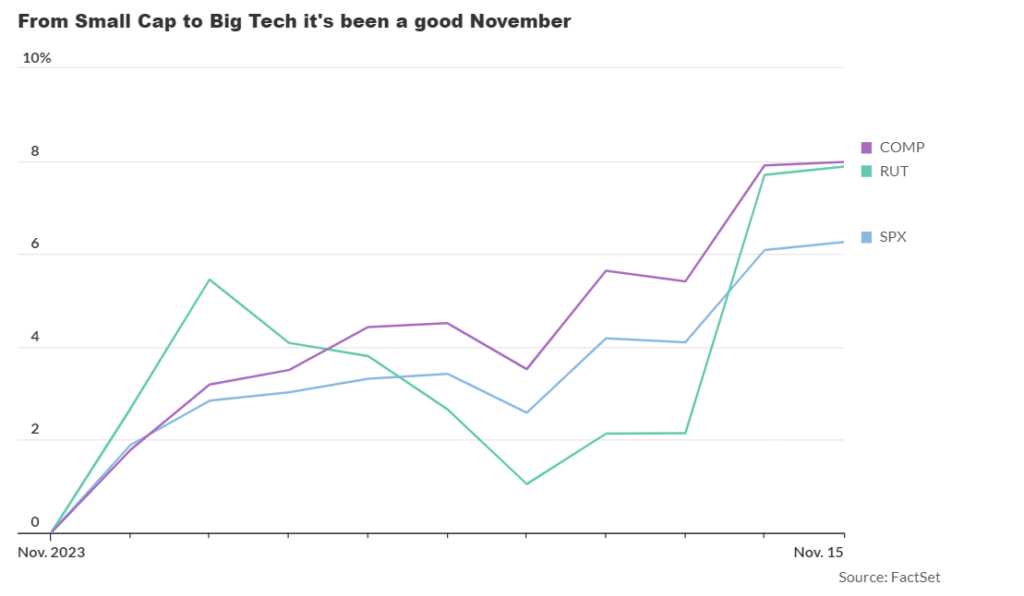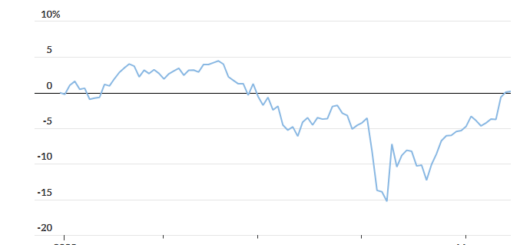S&P 500 Futures Showcase Resilience Following Robust Rally
On Thursday morning, the future predictions for the U.S. stock market showed little change, remaining near their highest point in the last two months. Traders were considering the recent significant increase in value.
How are stock-index futures trading
- The value of the S&P 500 futures, specifically ES00, decreased by 2 points or 0% to reach 4517.
- The value of the Dow Jones Industrial Average futures, denoted as YM00, decreased by 5 points or 0%, to reach a total of 35045.
- The NQ00, or Nasdaq 100 futures, dropped by 32 points or 0.2% to a level of 15857.
On Wednesday, the Dow Jones Industrial Average experienced a rise of 164 points, equivalent to a 0.47% increase, and closed at 34991. The S&P 500 also had a slight increase of 7 points, or 0.16%, resulting in a closing value of 4503. Similarly, the Nasdaq Composite saw a rise of 9 points, or 0.07%, and ended at 14104.
What’s driving markets
According to the futures market, stock market indexes are currently showing signs of stability after a period of good performance.
The S&P 500 is currently at its highest level since September 14th, having risen in value for 11 out of the past 13 sessions. It has gained 7.4% this month. The Nasdaq Composite, which focuses on technology stocks, has also seen an increase in value for 12 out of the past 14 days, with a 9.75% rise in November. The Russell 2000 index, which tracks small cap stocks, has seen an 8.4% increase during the same period.
The surge in rallies is primarily driven by the decline in borrowing costs. Over the last month, the 10-year Treasury yield has fallen from its highest point in 16 years, reaching a level of over 5%, to 4.50%. This decrease is linked to positive hopes that the U.S. job market will slow down and inflation will decrease, leading to the Federal Reserve implementing interest rate reductions by mid-2022.
Simultaneously, investors are becoming increasingly confident that the slight rise of approximately 500 basis points in interest rates by the Federal Reserve will not cause a substantial decline in the US economy. They are of the opinion that even if there is a mild economic slowdown, it will still be sufficient to help companies sustain their profits.
However, there are experts who are advising caution as the CBOE VIX index, which indicates anticipated market volatility, is nearing the level of 14 once again. Additionally, the S&P 500’s 14-day relative strength index has rapidly transitioned from showing that stocks are being sold at an excessive rate to approaching a state where they may be considered overbought, all occurring in just three weeks.
Stephen Innes, who is in charge of SPI Asset Management, expressed that the commencement of stock futures was unimpressive as there were concerns about the market progressing too quickly.
Traders and investors are worried that they may have made hasty assumptions about the impact of recent weak macro data in the United States on the Federal Reserve’s decision to implement an economic easing policy in the later part of the first quarter of 2024. Innes expressed concern that the markets may be overestimating the likelihood of the Federal Reserve fully accommodating the current situation.

Cisco Systems, after the market closed on Wednesday, announced unsatisfactory results, resulting in a decline of their stock by more than 10%. This occurrence highlighted the delicate nature of the market.
Walmart, Macy’s, and Williams-Sonoma will publish their financial outcomes before the beginning of the trading day. After the market closes, Applied Materials, Gap, and Beazer Homes will unveil their earnings.
Mark Newton, the person in charge of technical strategy at Fundstrat, has shown his support for the recent progress in the stock market. He is pleased to see that a greater number of shares are joining in the upward trend. Newton finds it encouraging that the gains are not exclusively reliant on major tech stocks. He believes that this increased diversification has the capability to sustain the market’s growth in the coming days.
Nevertheless, he acknowledged that while there may be instances where stock buying surpasses a sensible level due to current market conditions, this aligns with a consistently unfavorable pattern evident in weekly and monthly graphs. Consequently, it implies that any upcoming stock market growth is likely to encounter significant opposition. As a result, the potential advantages of investing in US Equities in the near future may not be as advantageous if there is another surge in value next week.

There will be updates about the U.S. economy on Thursday. These updates will cover the number of individuals who have filed for unemployment benefits for the first time in the week, the price index for imported goods in October, and a survey on manufacturing activity in Philadelphia in November. The reports will be accessible at 8:30 am Eastern Time.
The announcement of October’s industrial production and capacity utilization is planned for 9:15 a.m., and this will be followed by the release of November’s home builder confidence at 10 a.m.
A notable group of Federal Reserve officials will give speeches on Thursday. The lineup includes Loretta Mester, the President of the Cleveland Fed, speaking at 8:30 a.m.; John Williams, the President of the New York Fed, speaking at 9:25 a.m.; Michael Barr, the Vice Chair for Supervision at the Fed, speaking at 10:35 a.m.; and Lisa Cook, a Governor at the Fed, speaking at noon.




